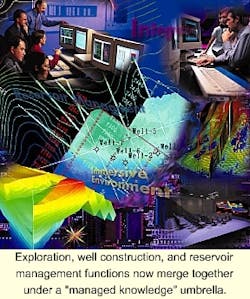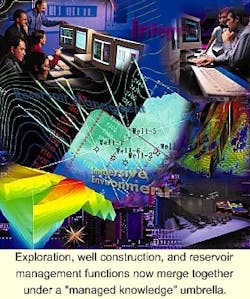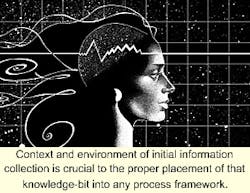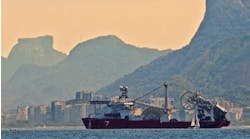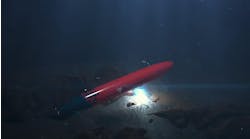PART II: This article is part of a series dealing with the preservation of the industry's intellectual capital. Part I focused on how intellectual capital is developed. Part II deals with process mapping and management. Part III, featuring technology, will appear in the next issue.
In the hype that surrounds knowledge, it can be confusing to even attempt to answer the question: "What is knowledge?" The statement, "Use a nine iron," could be considered knowledge to an avid amateur golfer. However, if one was standing at the ninth hole of St. Andrews Old Course, the value of this knowledge without its associated context is greatly diminished.
Along with knowledge, we must understand the environment in which it was created and proven successful in the past. This holds true for the knowledge about a drill bit being used, as much as it does for the golf club. Knowledge must be provided within a framework to render its usefulness. For example, if the knowledge, "use a nine iron," were provided to a golfer within the context of a golf course, the yardage and weather conditions in which it was originally recorded could be extremely useful.
But yardage is but one aspect of the knowledge framework. Clearly, there are other aspects. In the oil and gas industry, where multidimensional models are used to make effective interpretations of the subsurface, multidimensional frameworks are also necessary in order to make use of previous experiences.
One of the primary dimensions of an appropriate knowledge framework is understanding the process(es) in which the knowledge was created. When properly mapped, processes provide the context, so that advice such as: "Just hit the nine iron" is accompanied by who, what, where, why, and how. In the golf analogy, this equates to things like who was swinging the club, the type of ball being used, the type of terrain being hit from and towards, the results, and the lessons learned.
What is a process?
Miriam Webster defines a process as "a natural phenomenon marked by gradual changes that lead toward a particular result." Processes typically can be categorized into production-based, customer service-based, project-based, distribution-based or some combination of these. In Landmark's business, processes generally are groups of activities resulting in products or services, which eventually generate revenue.
The quest for greater revenues has driven the business process re-engineering (BPR) wave. There have been significant successes, but failures as well. From a process perspective, the failures include:
- Re-engineering the wrong processes
- Not realizing and providing for the dynamic nature of processes
- Underestimating the investment people had in the process.
Knowledge management is heavily dependent on process mapping, so care must be taken to avoid the same pitfalls. A process map may contain activities, business functions, inputs, outputs, cycle times, and decision points. These reveal where knowledge is used, how it is dispersed, and who uses it. Additional observations reveal where knowledge is created and where it resides.
Process maps offer the best way to understand where knowledge resides today in an organization. In trying to determine which processes an organization should map, look at the company's business strategy for help. Start by mapping the processes vital to a company's success. These maps are the "as-is" or current state processes. They are snapshots of what is occurring in today's environment. The objective is to learn from the past, but not necessarily repeat the same process.
Process management
Documenting business processes in the oil and gas industry is nothing new. In the late 1980s and early 1990s, during the reign of total quality management (TQM), most companies in the petroleum industry considered process mapping a vital element in TQM programs.
Typically, teams of stakeholders were rallied in a room filled with masses of post-it notes, large format paper, markers, and an objective facilitator to define the "as-is" process, brainstorm potential improvements, and document the new and improved practice. This work often resulted in increased efficiencies, reduced redundancies, decreased cycle-times, and allowed selecting the "low-hanging fruit."
For the more strategic processes, we often studied the "best-in-class" companies both inside and outside the petroleum industry, in order to benchmark and establish the best practices for whatever was being attempted. Visits to the likes of Motorola, Xerox, IBM, and Texas Instruments were made.
For the first time, we looked, not just at the direct expenses of the petroleum business to trim the bottom line, but analyzed how we were doing things in order to improve efficiency. Ultimately, most of us were able to reduce finding costs, lifting costs, and improve the bottom line return on investment. In retrospect, this flurry of activity benefitted the industry, but we still had a long way to go before we could claim ultimate victory.
Process mapping
So, if this was so wonderful, then what is the problem? Some might say that process mapping is too difficult, a waste of time, or "out of fashion." Recent interactions with major and independent oil and gas producers continue to show that they realize the importance of focusing on processes. This is further evidenced by the fact that hundreds of millions of dollars have been made and an industry built around the business of helping companies understand and improve their processes.
One only needs to do a search for "process management" on the Worldwide Web to see the myriad of companies that would gladly assist in such an endeavor. However, the methods used in the past are no longer applicable today, as evidenced by the multitude of processes mapped, never looked at again, and are now resting peacefully in a file room.
One problem of traditional process mapping is documenting the "how to" of doing something. We then record generically the inputs, outputs, steps, decision points, and alternative paths, based on the decisions. We even go to the trouble of defining a "best practice." As an example, based on the collective experiences and measured results, "this is the best or most successful way to fracture a well."
However, given today's world, process mapping alone does not constitute knowledge management and only marginally contributes to the objectives of retaining knowledge and its impact on bottom line business decisions.
Managing amidst chaos
We need more than the recipe for a process to qualify as "knowledge." Why? By human nature, we innately fill in lacking information to form a context for anything that is presented to us. Without such context, even given the recipe for a process, individuals will either ignore it or will form context based on their own experiences.
To realize the maximum business value of retaining corporate memory around processes, we must be able to recreate the environment in which the process was executed. Given the opportunity to re-use the knowledge, we must judge today's context against the context when the knowledge was created. Without this, the process and associated knowledge are only minimally useful.
Within any process framework, one must be careful how knowledge is translated into the knowledge system. "Pre-packaged" knowledge packets tend to place the organization in a mode of blind acceptance (the attitude that "it must be right because it's in the system"), or to completely ignore them (the attitude of "I don't believe this, because I don't know who, why or what the circumstances were when it was put into the system").
Distillation of knowledge into a form that is acceptable by most structured information technology systems renders it almost useless because the mere act of doing this generally works against the retention of multiple viewpoints and disagreements. This explains why it is so vitally important to capture not just the recipe or steps of a process, but more importantly, the surrounding context, including differing opinions, discussions, results, related documentation (both formal and informal), e-mails, phone calls, alternatives considered, and metaphors used.
Managing the knowledge in a changing environment is not merely an exercise in digitally capturing everything done or said during process. To relate to someone else's knowledge, one may need to assume the other person's position physically, psychologically, and intellectually.
Hence, the need for any knowledge management system to provide not just information technology, but also connect to others who have been involved in past execution of similarly captured processes. It is necessary to position themselves in the others' mental model. Knowledge re-use is severely restricted without the active inquiry of human participants. This inquisition is part of the continuous assessment of the current value.
Best practices?
As mentioned earlier, the gathering of best practices has been commonplace in the oil and gas industry since the early 1990s. This effort generally began in organizations as a way to define the standard methodology for executing processes in order to create superior results.
Given the tumultuous environment in which we do business, consider the fact that it is likely more advantageous to collect the process and its accompanying framework for all activities rather than purporting that one is best. Inadvertently, through the use of best practices, organizations can find themselves doing more of the same, better and better. While this may be more acceptable for production line/manufacturing type organizations, doing "more of the same" within the petroleum industry ultimately results in the "best buggy whip" trying to compete against motorcars.
There is a need for ongoing reassessment of what is best. One might even consider the fact that there is no such thing as a best practice. What we historically have thought of as best practices really serve as a source of creative insight rather than the one irrefutable answer to a business problem. The insight begins with the questions: "Does this practice make sense in my situation?" and "What can I learn from it?"
